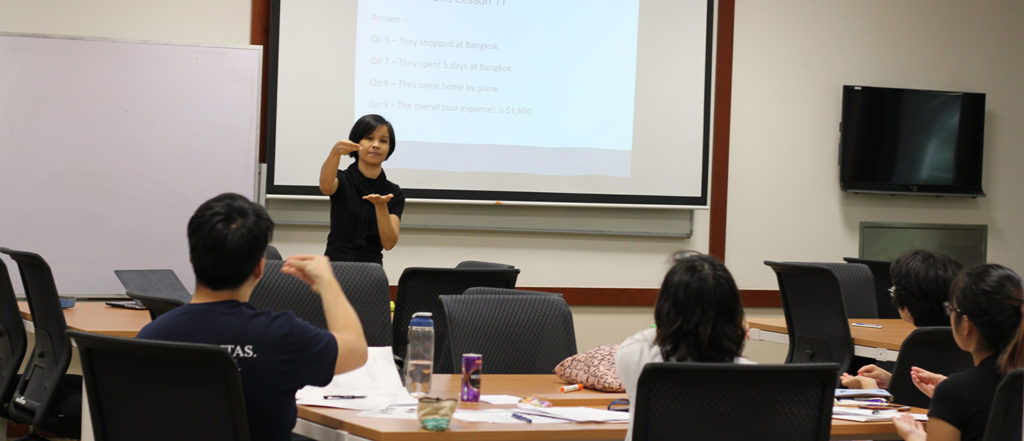Yale-NUS students gain awareness of the Singapore Sign Language and deaf culture

Yale-NUS College is a special place, which provides a well-rounded liberal arts education, both in and out of the classroom. Conceived with the fundamental focus of fostering students to be authors of their own experience, the College actively welcomes ideas proposed by students who are keen to further develop their intellectual curiosity beyond the official curriculum. The College has grown to become a lively space teeming with student-generated ideas, where some support academic exploration while others advocate practice-based learning that transcends beyond the College to the wider community. Testament to this, a new co-curricular course on sign language was recently initiated and implemented by three students who had both personal interests and a common desire to introduce fellow students to the deaf culture and community in Singapore.
“I have always wanted to learn sign language because I am interested to learn more about the deaf community and inclusion from a disability perspective. It challenged my preconceptions about what it means to communicate as well as the idea that deafness should be viewed as a disability when it really is just a different form of ability. I suggested organising a sign language class on campus to some friends and two of them – Anthea Chua and Khwa Zhong Xuan (both Class of 2020) – took the initiative and worked with the Dean of Students office to make it happen”, explained Daryl Yang (Class of 2018), who enrolled in the class.
The sign language classes were facilitated by teachers from The Singapore Association for the Deaf (SADeaf). As part of the Level One Singapore Sign Language Programme offered by them, students can expect to develop capabilities in non-verbal, visual-gestural communication, Singapore Sign Language (SgSL) vocabulary and structure as well as gain greater awareness of deaf Culture. To reinforce the learning experience, classes are taught using a “no-voice” teaching method.
“Teaching sign language can be a huge challenge, especially when the students are used to verbal communication. With the “no-voice” teaching method, I have to constantly remind the learners to use their hands, body and facial expression to communicate albeit been awkward initially”, clarified Ms Yam Lim, the facilitator from SADeaf.
For Ms Lim, her decision to teach sign language stemmed from the inspiration she got from her teachers during her schooling years and more than anything, her urge to build awareness about this unique language and the deaf culture. With stereotypes about deafness still persisting in mainstream society, she desired for Singaporeans to be more socially aware of the deaf and to maintain a right attitude towards the community.
In fact, almost all the participants in the sign language class at the College are new learners. “Through these classes, what intrigued me the most was that you have different ‘dialects’ of sign language. The sign language used in Singapore differs from that of others used elsewhere in the world. In addition, I gained a lot of ‘insider information’ as to how local gestures are formulated. For example, the gesture for Marina Bay Sands is formed with three fingers vertical and a finger horizontal atop- a direct parallel to its physical image”, remarked Goh Wan Ling (Class of 2021), a student in the class.
Echoing this, Daryl commented, “SgSL is a very young language and is constantly evolving. This means that there often are words for which we need to think creatively to express through what is called Visual-Gesture Communication (VGC), which we learnt during our course as well”.
Indeed, sign language is a general term ascribed to a group of languages that are manually produced and visually understood. However, it is not a universal language for every state or community with deaf persons will develop their own unique sign language. The Singapore Sign Language (SgSL) is the amalgamation of Shanghainese Sign Language (SSL), American Sign Language (ASL), Signing Exact English (SEE) and locally developed signs.
Beyond the classroom, students learnt to apply their sign language skills in their daily lives. “What I found truly fascinating is that at most times our instructor could clearly express herself and teach us without talking or writing. Being inspired, I now try to sign sentences every other day. Whether it’s talking to friends or the cashier, I try to sign sentences after the conversation has ended”, said Deeptha Sharon Samuels (Class of 2021), another participant who took the class.
On the current landscape regarding the deaf culture and community, Ms Lim found it incredibly heartening that the general community is more inclusive than before and the deaf are increasingly integrated into society. “I’ve come across many hearing people signing fluently these days. Their tenacious efforts and passion attitude have won my admiration.”





